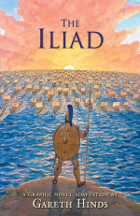The Iliad - a graphic novel adaptation by Gareth Hinds

Candlewick Press 2019. ISBN: 9780763696634.
Themes: Ancient Greece, myths/ legends. Homer's epic poem, about the
tenth year of the Trojan War, fought around the twelfth century BCE,
has endured as one of the greatest war stories of all time, but it
is more than a war story, it is one of human heroism and failings,
and the interference of gods. To help understand the work, all in
beautiful fine watercolours, Hinds presents us with an illustrated
cast of characters, important Achaeans, mainly in blue (Greeks) and
Trojans, mainly in red, explaining that each character's initial can
be found worked into his armour. The other important players are the
twelve Gods who are depicted in semi-transparent pastel shades.
A prologue sets the scene, explaining the modern day location of the
warring armies, how the war started and the involvement of the Gods.
The story picks up as the battle weary Achaeans, camped outside the
fortress of Troy make offerings to appease the Gods who have brought
sickness to the camp. It is seen that the Gods are angry about the
refusal to ransom the daughter of Apollo's priest, taken as a war
spoil by Agamemnon, the leader of the Achaeans. He agrees to give
her up but claims Achilles' woman Briseis in return. A well placed
footnote explains that the army had been raiding allies of Troy and
that men and women became slaves, valuable 'spoils of war'. Achilles
is furious and withdraws his support. The war continues with the
upper hand shifting backwards and forwards between the two armies
often influenced by the Gods who struggle to exert dominance over
each other. Brave men die on the battlefield, their names recited,
ensuring everlasting fame and honour for their families.
The famous finale between the Trojan hero Hector and Achilles is
gripping, it is a bitterly fought battle vividly brought to life in
the illustrations. The author's note at the end reflects on why we
still read the Iliad. 'Humanity is on display with all its nobility
and pettiness and violence and tenderness, it is, simply, a powerful
story.'
Introducing a new readership to some of the most important works of
Western literature has been the goal of Gareth Hinds' wonderful
adaptations of classics such as Beowulf, the plays of Shakespeare,
and this companion volume to The
Odyssey. The adaptation retains the essence of the original
with helpful maps and notes but some students may find it long and
challenging. However, the characters are the original superheroes
and the story compelling, while senior students will find it
rewarding it will also appeal to action graphic fans of all ages.
Sue Speck